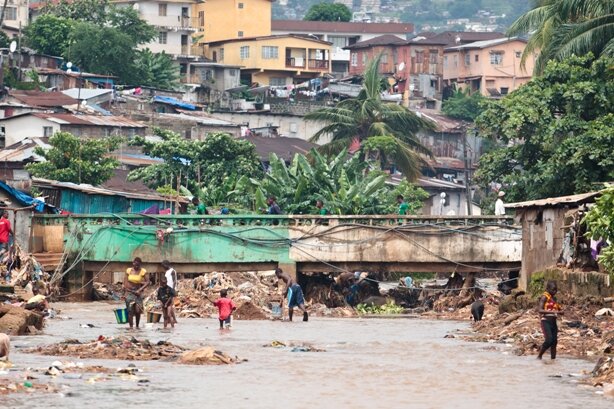By Dr. Gregory Simon, Senior Technical Officer, Global Network for Neglected Tropical Diseases
In lake and ponds, rivers and dams, people in developing countries throughout Africa, Asia and Latin America come in contact with parasites that can cause debilitating disease and sometimes death. More than 200 million people around the world are infected with the disease, known as schistosomiasis, often while swimming, bathing, fishing or simply doing domestic chores like laundry and herding livestock. This is because the disease is carried by fresh water snails and transmitted by contact with contaminated fresh water.

Dirty stream in the Kroo bay slum of Freetown, Sierra Leone. Wading in standing water in schistosomiasis endemic areas puts people at risk of contracting the disease. By Olivier Asselin, 2012.
A recent mapping survey was conducted in Sierra Leone to determine the infection rates of schistosomiasis and soil transmitted helminths (STH) as part of routine surveillance performed in different areas and during different phases of preventative treatment known as mass drug administration (MDA, click here to learn more about how MDA is used treat and prevent diseases like schistosomiasis and STH). The results were somewhat surprising. The researchers found that preschool age children had high levels and heavy infections of schistosomiasis. But not STH.
The national control program currently does not target this group of children for schistosomiasis treatment or prevention, while MDA has been performed twice yearly for STHs in children 12-59 months of age since 2006.
The survey in Sierra Leone underpins a major problem with international efforts to control and eliminate schistosomiasis.

A woman holds her daughter at the Masongbo health center in the town of Masongbo, Sierra Leone. Health centers offer an alternative to ensure preschool aged children receive preventative treatment for schistosomiasis. By Olivier Asselin, 2012.
The current recommendations by the World Health Organization (WHO) do not include treatment protocols for pre-school age children within the context of an MDA strategy. Instead, the WHO recommends treatment of schistosomiasis in children aged less than 4 years on an individual basis by medical personnel.
Without an effective, safe way of administering schistosomiasis pills to pre-school age children, the spread of the disease in households and communities will not be halted. For the time being, in the absence of an appropriate pediatric formulation, broken or crushed tablets are recommended. Research is being conducted on a pediatric formulation that can be used for mass administration; however, approval for such a formulation could be some time away.
Until such a time, when a formulation for MDA in preschool aged children is approved, a potential strategy could be to have children in this age group treated in child health services where children are given vitamin A capsules, treatment for STH and routine vaccinations.
Learn more about schistosomiasis by visiting globalnetwork.org/schistosomiasis.
